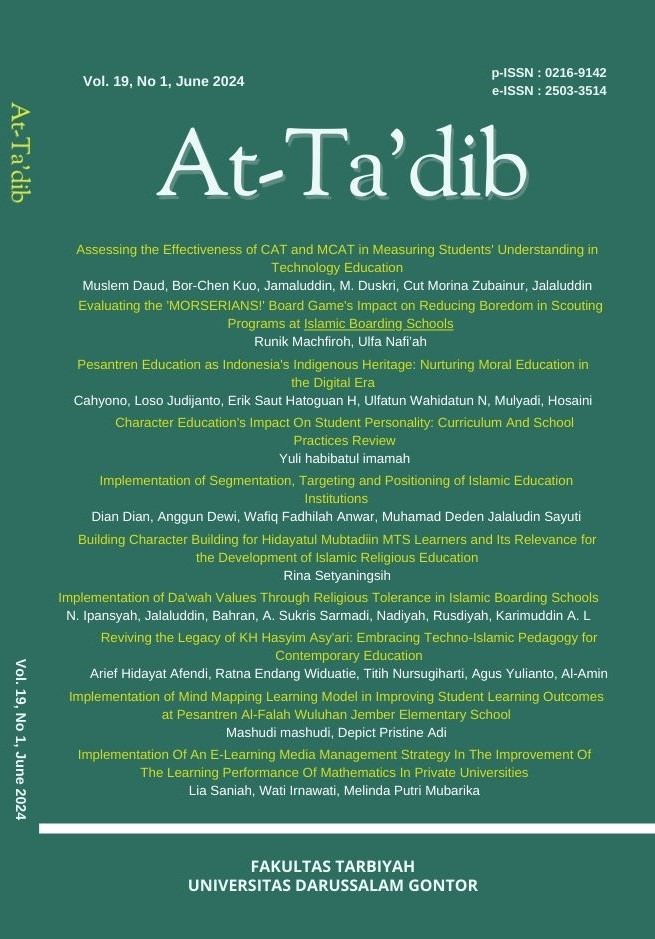Reviving the Legacy of KH Hasyim Asy'ari: Embracing Techno-Islamic Pedagogy for Contemporary Education
DOI:
https://doi.org/10.21111/attadib.v19i1.12247Keywords:
Islamic Pedagogy, Technology, Islamic EducationAbstract
KH Hasyim Asy'ari underlined the significance of instruction as a implies to construct devout and national mindfulness. He accepted that instruction ought to be able to deliver people who are not as it were learned people cleverly, but moreover have tall ethical and otherworldly astuteness. Joining conventional values within the innovative approach to instruction requires alterations to the educational programs and instructing strategies. Techno-Islamic Instructional method underlines the utilize of innovation to bolster student-centred learning, whereas keeping up Islamic values.Qualitative-literature study methodology is a research approach that emphasises in-depth analysis of relevant literature in a field of research. The results Adjusting KH Hasyim Asy'ari's bequest into Techno-Islamic Instructional method is an imperative step in progressing the quality of Islamic instruction within the present day time. By coordination technology and Islamic values, we will make an instruction framework that's not as it were scholastically compelling but too shapes the character of understudies with respectable characterReferences
Abdul Mujib dan Jusuf Mudzakkir. Ilmu Pendidikan Islam. Jakarta: Kencana, 2006.
Abror, Ahmad Auladul, dan Ulfatun Wahidatun Nisa. “AT-TA’DIB: ISLAMIC SOLUTION FOR NEGLECTFUL PARENTING†2, no. 1 (2024).
Ahmad Zubaidi, Burhan Nudin, Edi Safitri, dan Junanah. Imajinasi dan Reflesi Kritis pengembangan Pendidikan Islam. Trenggalek: CV Indonesia Imaji, 2022.
Azra, Azyumardi. The Origins of Islamic Reformism in Southeast Asia: Networks of Malay-Indonesian and Middle Eastern “UlamĆin the Seventeenth and Eighteenth Centuries. Asian Studies Association of Australia. Crows Nest Honolulu: Allen & Unwin University of Hawai’i press, 2004.
Creswell, John W. Qualitative Inquiry and Research Design (International Student Edition). Choosing among Five Approaches. 4th edition. London: SAGE Publications, 2017.
Denzin, Norman K., dan Yvonna S. Lincoln, ed. The Sage Handbook of Qualitative Research. Fifth edition. Los Angeles: Sage, 2018.
Fauzan, Ady, Dihin Muriyatmoko, dan Shoffin Nahwa Utama. “Penerapan Teknologi Augmented Reality pada Media Pembelajaran Bahasa Arab: Durus Al-Lughah Jilid 1.†ELSE (Elementary School Education Journal) : Jurnal Pendidikan dan Pembelajaran Sekolah Dasar 4, no. 1 (27 Februari 2020): 63. https://doi.org/10.30651/else.v4i1.4379.
Harun Nasution. Ensiklopedi Islam Indonesia. Jakarta: Djambatan, 1992.
Hefner, Robert W., ed. Routledge Handbook of Contemporary Indonesia. First issued in paperback. Routledge Handbooks. London New York, NY: Routledge, Taylor & Francis Group, 2018.
Hidayat, Moch. Charis, Sokhibul Arifin, Asrori, dan Rusman. “Integration Science Technology with Islamic Values: Empowering Education Model.†Dalam Proceedings of the 1st Borobudur International Symposium on Humanities, Economics and Social Sciences (BIS-HESS 2019). Magelang, Indonesia: Atlantis Press, 2020. https://doi.org/10.2991/assehr.k.200529.202.
Ichwan, Rizqi Mediansyah, dan Pradipta Putra Abimata. “Efektivitas Pembelajaran Daring di Fakultas Teknologi Industri Universitas Islam Indonesia.†Jurnal Sains, Nalar, dan Aplikasi Teknologi Informasi 3, no. 1 (6 Oktober 2023): 16–22. https://doi.org/10.20885/snati.v3i1.27.
Jeremy Henzel dan Thomas. “Excellence in Islamic Education: Key Issues for the Present Time,†t.t. from https://thebook.org/resource/aoe6.html.
Lukens-Bull, Ronald. A peaceful Jihad: negotiating identity and modernity in Muslim Java. 1st ed. Contemporary anthropology of religion. New York: Palgrave Macmillan, 2005.
Martin Van Bruinessen. Kitab Kuning: Pesantren dan Tarekat. Bandung: Mizan, 1995.
Mohammad Hasan. “PERKEMBANGAN PENDIDIKAN PESANTREN DI INDONESIA.†TADRIS: Jurnal Pendidikan Islam 10, no. 1 (2015). https://doi.org/10.19105/tjpi.v10i1.638.
NU tradisi relasi-relasi kuasa pencarian wacana baru. Yogyakarta: LKiS, 1994.
Ricklefs, M. C. Polarizing Javanese Society: Islamic and Other Visions, c. 1830-1930. Leiden: KITLV Press, 2007.
Sholeh, Muh Ibnu. “Technology Integration in Islamic Education: Policy Framework and Adoption Challenges.†Journal of Modern Islamic Studies and Civilization 1, no. 02 (7 Agustus 2023): 82–100. https://doi.org/10.59653/jmisc.v1i02.155.
Silverman, David, ed. Qualitative research. 4E ed. Los Angeles: Sage, 2016.
S.M.N Al-Attas. The Concept of Education in Islam: A Framework for an Islamic Philosophy of Education. Kuala Lumpur: International Institute of Islamic Thought and Civilization, 1999.
Syamsul Arifin. Kiai Hasyim Asy’ari: Pengabdian Seorang Ulama. Jakarta: LKiS, 2011.
Ulfatun Wahidatun Nisa. “ISLAMIZATION OF KNOWLEDGE AND ITS CHALLENGE.†Dalam PROCEEDING OF INTERNATIONAL CONFERENCE ON EDUCATION, SOCIETY AND HUMANITY. Probolinggo: UNUJA, 2023.
Yumnah, Siti. “Character Education with Islamic Insights of The Nusantara.†Nazhruna: Jurnal Pendidikan Islam 4, no. 3 (20 Oktober 2021): 547–62. https://doi.org/10.31538/nzh.v4i3.1597.
Downloads
Submitted
Accepted
Published
How to Cite
Issue
Section
License
Copyright (c) 2024 Arief Hidayat Afendi, Ratna Endang Widuatie, Titih Nursugiharti, Agus Yulianto, Al-Amin

This work is licensed under a Creative Commons Attribution-ShareAlike 4.0 International License.
Copyright Notice
Authors who publish with this journal agree to the following terms:
- Authors retain copyright and grant the journal right of first publication with the work simultaneously licensed under a Creative Commons Attribution License that allows others to share the work with an acknowledgment of the work's authorship and initial publication in this journal.  Creative Commons Attribution-ShareAlike 4.0 International License.
- Authors are able to enter into separate, additional contractual arrangements for the non-exclusive distribution of the journal's published version of the work (e.g., post it to an institutional repository or publish it in a book), with an acknowledgment of its initial publication in this journal.
- Authors are permitted and encouraged to post their work online (e.g., in institutional repositories or on their website) prior to and during the submission process, as it can lead to productive exchanges, as well as earlier and greater citation of published work.
- The author warrants that the article is original, written by stated author(s), has not been published before, contains no unlawful statements, does not infringe the rights of others, is subject to copyright that is vested exclusively in the author and free of any third party rights, and that any necessary written permissions to quote from other sources have been obtained by the author(s).

AT-TA'DIB: Journal of Pesantren Education Published by Faculty of Tarbiyah, University of Darussalam Gontor, Indonesia is licensed under a Creative Commons Attribution-ShareAlike 4.0 International License.
Based on a work at https://ejournal.unida.gontor.ac.id/index.php/tadib/index








